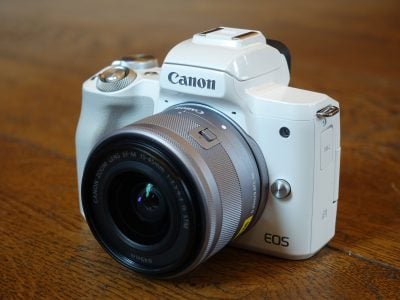Panasonic Lumix DMC-FZ18
-
-
Written by Gordon Laing
Panasonic Lumix DMC-FZ18 lens coverage
More features : Lenses / Screen and menus / Sensor and processing / anti-shake
Panasonic Lumix DMC-FZ18 features continued…
Lenses / Screen and menus / Sensor and processing / anti-shake
The Panasonic Lumix FZ18 is equipped with a Leica DC Vario-Elmarit 18x optical zoom delivering an equivalent range of 28-504mm with a focal ratio of f2.8-4.2; the actual focal length is 4.6-82.8mm and the closest focusing distance is 1cm in Macro mode with the lens zoomed all the way out.
The lens represents the FZ18’s key difference with its predecessor, offering both wider and longer coverage than the earlier FZ8’s equivalent of 36-432mm. The focal ratio may be slightly slower when fully zoomed-in, but the FZ18 can still operate at f2.8 when zoomed-out. The closest focusing distance in macro mode has also been greatly improved from 5cm to just 1cm and in practice the outer barrel of the lens can actually touch the subject while still remaining in focus.
Upon power-up the lens barrel extends by just 8mm (compared to 21mm for the FZ8) and does so swiftly in just over a second. Fully zooming the lens extends the barrel to a maximum length of 25mm, which is roughly equivalent to the earlier FZ8. We’re also pleased to report while the FZ18 has a new lens, Panasonic’s kept the same very fine increments as you explore its range. There’s no lurching from one focal length to another here – we found it virtually impossible to count discrete steps, but impressively you’re looking at over 70. The FZ18 also offers two different zooming speeds, depending on how far you push the zoom rocker; in leisurely mode it takes about six seconds from one end to the other, or about 2.5 seconds when pushed all the way.
The FZ18’s new lens is without a doubt the major highlight of the camera. The range of its predecessor was certainly impressive, but we really missed proper wide angle coverage, especially as it was present on virtually every other Panasonic camera along with rival super-zooms including the Olympus SP-550UZ. Now with the FZ18 Panasonic’s budget super-zoom has the wide angle coverage it deserves, along with a slight boost at the telephoto end too. And you still also get effective optical image stabilisation which we’ll demonstrate later.
To illustrate the Lumix FZ18’s coverage in practice we mounted it on a tripod and took photos with the lens fully zoomed-out, then fully zoomed-in. For comparison we then mounted a Fujifilm FinePix S8000fd in the same position and again took shots at the short and long end of its focal range.
 |
Panasonic Lumix DMC-FZ18 coverage wide |
Fujifilm FinePix S8000fd coverage wide | |
 | ||
4.6-82.8mm at 4.6mm (28mm equivalent) |
4.7-84.2mm at 4.7mm (27mm equivalent) |
Both cameras sport 18x optical zooms, but the equivalent ranges are slightly different. Panasonic’s FZ18 offers an equivalent range of 28-504mm, while Fujifilm’s S8000fd offers 27-486mm. One millimetre difference at the wide angle end doesn’t sound like much, but judging from the samples above, the Fujifilm does indeed capture a slightly wider field of view – the mountain range extends a little further in both directions, and slightly more of the town is visible.
Panasonic Lumix DMC-FZ18 coverage tele |
Fujifilm FinePix S8000fd coverage tele | |
 |  | |
4.6-82.8mm at 82.8mm (504mm equivalent) |
4.7-84.2mm at 84.2mm (486mm equivalent) |
Zoom both cameras in fully and they appear to deliver the same result as seen above, but look very closely and the Panasonic is fractionally tighter, although not so much it makes any real difference. So technically speaking, the Fuji gets a little wider and the Panasonic fractionally closer, but there’s really not much between them in terms of coverage. Both cameras offer a fantastically versatile range which covers almost every eventuality; there are however differences in their optical quality which we’ll cover later.
 |
If the FZ18’s optical range isn’t long enough, you can fit the optional (and rather substantial) DMW-LT55 tele conversion lens which multiples the range by 1.7x, giving a maximum effective focal length of 857mm. There’s also an optional DMW-LC55 lens which improves close-up capabilities, although they’re already pretty good with the FZ18. Unlike its predecessor though, there’s no wide angle converter listed as an accessory – but again the 28mm equivalent coverage of the FZ18 will suffice for most people. Note both the FZ18’s lens converters require the optional DMW-LA3 adapter for mounting.
Like its predecessor, the FZ18 is supplied with a petal-style lens hood which mounts onto the body via a screw-on filter ring which is also supplied. Once you have this ring and lens hood attached, the FZ18 inevitably looks much bigger, but it’s nowhere in the same league as the monster which Sony supplies with its Cyber-shot DSC-H9.
Unlike many lens hoods which clip into place, the FZ18s, like that supplied with its predecessor, can be freely rotated before you tighten a screw to hold it in position. This runs the risk of the hood not being turned to the correct position, and therefore causing some vignetting on wide angle shots. We’ve spotted several people using their FZ8s with the lens hood mounted incorrectly, so it’s a worry the same is possible again here. So while we’re pleased to find a lens hood supplied, any chance of a foolproof mounting next time?
Panasonic Lumix DMC-FZ18 focusing
 |
 |
The Panasonic FZ18 offers the same five main auto-focusing modes as its predecessor along with a new face detection option. The five main modes consist of Multi-area, Three area high speed, Single area high speed, normal single area, and spot focusing. They also operate the same as before: the Multi-area mode is the most useful in general use, checking areas around the frame. The high speed modes restrict focusing to three or even just a single point in the middle for quicker response. It’s also possible to manually select one of 11 AF areas in the single area modes – or a set of areas in Multi mode. New to the FZ18 is face detection, which can recognise up to 15 faces on the frame and adjust focus and exposure as required.
In use the FZ18 focuses quite quickly, and the higher speed modes are quicker still. It’s still not in the same league as Sony’s Cyber-shot DSC-H9, but not bad none-the-less. During our tests the face detection worked as described.
The FZ18 also offers a manual focusing option, operated by the tiny joystick on the back. During manual focus, a distance scale is shown vertically on the right with a scroll bar representing the depth of field – so the bar increases in size to cover a larger range of distances as the aperture is closed. It’s a handy graphical representation in practice. Like its predecessor, manual focusing enlarges a central area for closer examination, but there’s now a second option which fills the screen with the enlargement.




